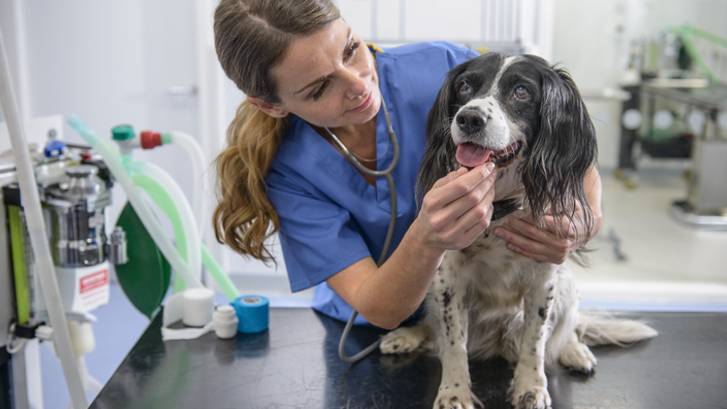Diabetes in dogs: a vet's guide
Diabetes in dogs isn’t a condition to take lightly, but it can often be successfully managed

Diabetes in dogs is a relatively common endocrine (hormonal) disease, affecting approximately 1 in 300 dogs. This condition has no single, identifiable cause, and is probably caused by a combination of factors.
If your dog is diagnosed with diabetes, you will need to work carefully with your veterinarian to create a diabetes management plan for your dog. In addition to twice-daily insulin injections, this management plan will likely include specific dietary recommendations, the best diabetic dog food, and regular monitoring of your dog’s diabetes and overall health.
- Best diabetic dog treats
- Hypoglycemia in dogs: A vet's guide
- Diabetic ketoacidosis in dogs: A vet’s guide
What is diabetes?
When your veterinarian mentions “diabetes,” they are probably referring to diabetes mellitus in dogs. There is another type of canine diabetes, called diabetes insipidus, but it is less common and veterinarians typically refer to it by its full name. The shorthand term “diabetes” usually means diabetes mellitus.
A dog with diabetes mellitus does not produce enough insulin to meet their body’s needs. Insulin is a hormone, produced in the pancreas, that moves sugar from your dog’s bloodstream into the body’s cells. Without insulin, sugar cannot be transported into your dog’s cells and instead remains in the blood, causing hyperglycemia (high blood sugar). A diabetic dog’s cells are starving, despite being awash in a sea of sugar.
What causes diabetes in dogs?
There is no single identifiable cause of diabetes, but there are factors that can make a dog more likely to develop this condition. Diabetes is usually diagnosed in middle-aged and older dogs, and it’s more common in dogs that are overweight or obese.
Dogs with recurrent episodes of pancreatitis are more likely to develop diabetes, because recurrent pancreatitis can cause permanent damage to the pancreatic cells responsible for producing insulin. Cushing’s disease (a hormone imbalance that results in the overproduction of steroids) is a common endocrine disease in dogs that may also lead to the development of diabetes.
Diabetes in dogs symptoms
In most dogs, the first sign of diabetes is an increase in thirst and urination. You may notice that your dog is drinking large volumes of water, or stopping by their water bowl more often. This will be accompanied by needing to go outside more frequently and urinating larger volumes.
Diabetic dogs also tend to lose weight, despite having a ravenous appetite. If your dog is constantly hungry and eats anything you put in front of them, yet they still appear to be losing fat and muscle mass, diabetes may be to blame.
Diabetes also can lead to the formation of cataracts in the eyes. You may notice that your dog’s eyes have a cloudy appearance, and/or that your dog is having trouble seeing. Diabetes can also affect the immune system, leading to recurrent skin and urinary tract infections.
How will my veterinarian diagnose diabetes?

The first step in diagnosing diabetes is to perform blood testing and a urinalysis. If your dog has hyperglycemia (elevated blood sugar) combined with glucosuria (sugar in the urine), diabetes is likely to blame. Additional testing may be needed if your dog has borderline results.
If your dog is diagnosed with diabetes, your veterinarian will likely recommend looking for additional conditions that are common causes or effects of diabetes. For example, your veterinarian may recommend testing your dog for Cushing’s disease. Cushing’s disease can contribute to diabetes, and successful treatment will require managing both conditions.
Your veterinarian may also recommend a urine culture and sensitivity test. Bladder and kidney infections are common in dogs with diabetes, and they can make diabetes challenging to manage.
How do you treat diabetes in dogs?
Insulin injections are a mainstay of diabetes treatment in dogs. You will work closely with your veterinarian to determine the optimal amount of insulin for your dog through careful monitoring. Insulin injections are typically given twice daily, with a meal.
Your veterinarian may prescribe a low-carbohydrate diet for your dog. This can minimize fluctuations in your dog’s blood sugar, thus minimizing the signs of diabetes. Your veterinarian may also recommend limiting treats, or giving low-carbohydrate treats. If you enjoy cooking, talk to your veterinarian to find out whether diabetic dog treat recipes are a good option for your dog.
Dogs with diabetes also require careful monitoring. Finding the optimal insulin dose can take a while, and your dog’s insulin needs may change over time. Any sort of illness, such as a urinary tract infection or dental disease, can affect your dog’s diabetes, and vice versa. Your vet will talk to you about how to monitor your dog at home, but you should also plan on seeing your veterinarian weekly during the initial stages of your dog’s diabetic regulation. Once your dog’s diabetes is well-managed, you will likely see your veterinarian every three to six months to assess your dog’s health and diabetic control.
Can diabetes in dogs be reversed?
Unfortunately, diabetes in dogs is a permanent condition. There are very rare exceptions, but almost every dog that is diagnosed with diabetes will go on to require insulin for the remainder of their life.
The good news is that controlling your dog’s diabetes with insulin should resolve your dog’s clinical signs of illness, and give your dog a relatively normal life. Once your dog’s blood sugar is regulated, their water intake and urination should return to normal, their appetite will decrease, and they will begin to gain weight. If your dog has developed cataracts as a result of diabetes, you may want to consider cataract surgery.
Summary
Diabetes in dogs can be a frustrating condition to manage. The good news, though, is that with proper veterinary care, most dogs with diabetes can go on to live a happy, healthy life. Work with your veterinarian to regulate your dog’s diabetes with insulin, and follow your veterinarian’s recommendations when selecting your dog’s diet and treats. These steps, along with regular veterinary monitoring, can help minimize the impacts that diabetes will have on your dog’s quality of life.
PetsRadar Newsletter
Get the best advice, tips and top tech for your beloved Pets
Dr. Barnette is a graduate of the University of Florida, where she received both her B.S. in Zoology and her Doctor of Veterinary Medicine (DVM). She has 15 years of clinical experience as a small animal veterinarian, treating dogs, cats, and occasional exotic patients. She now works as a freelance veterinary writer, creating educational content for veterinarians, veterinary team members, and dedicated pet owners. Dr. Barnette lives in southwest Florida with her husband and daughter (plus two cats, a dog, and a rescued dove!) and enjoys kayaking, biking, and hiking. Learn more about Dr. Barnette at www.linkedin.com/in/catherinebarnette.

